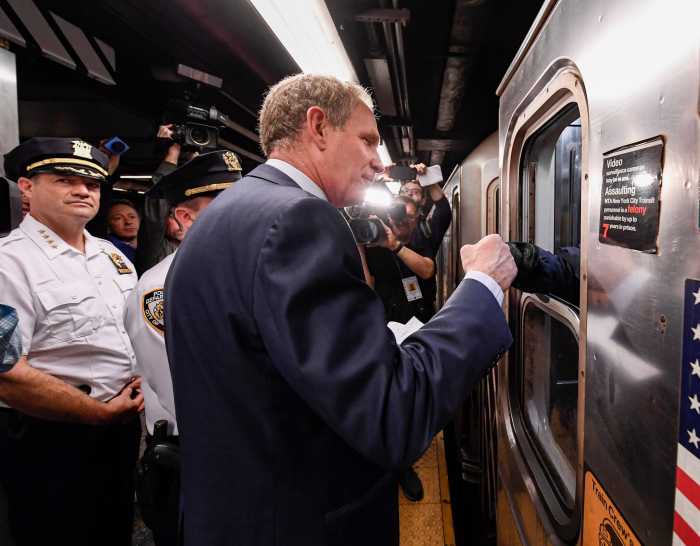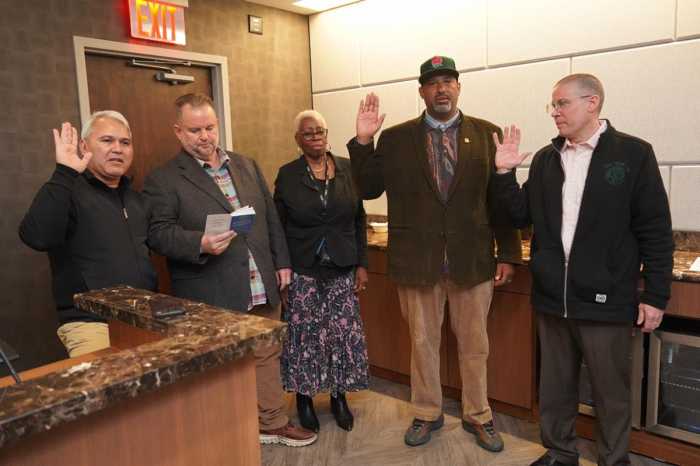A NYC urban planning research group published a study about train operation, calling on the MTA to make a driverless system for its planned Interborough Express (IBX) rail line through Brooklyn and Queens.
As part of its study, NYU’s Marron Institute of Urban Management reviewed more than 400 trains in dozens of countries and found that fewer than 6.25% of the systems have two staffers on board.
But the researchers, who have written extensively about IBX land-use topics, are specifically advocating for MTA’s most anticipated projects to be built as a fully automated system, eliminating the need for on-board staff, including train operators, to optimize the light-rail’s speed and efficiency.
“Ideally, IBX will be fully automated when it opens so that it can operate the most robust service possible,” researchers wrote in the study.
Eric Goldwyn is a program director and clinical assistant professor at Marron who contributed to the Nov. 13 study. He told amNew York that the IBX should “absolutely” be automated to enhance speed and service.
“When you have a subway, the most important thing is reliability and frequency,” the researcher said. “And the way you have the highest frequency is through automated operations.”
A fast ride is a strong selling point for the IBX. The MTA has promised that a full one-way ride on the proposed 14-mile, 19-stop light-rail will take about 33 minutes—a far cry from the nearly two-hour commute on most trains to the outer boroughs that have to run through Manhattan.
 The proposed IBX route.Image courtesy of the MTA
The proposed IBX route.Image courtesy of the MTA
Goldwyn suggested that train headway (the amount of time between consecutive trains) can be shortened with automation, thus supporting a quick commute.
“There are train lines in the world that run every 90 seconds,” he said. “And with the IBX, that should be our goal.”
Goldwyn might be on to something. Vancouver’s SkyTrain uses fully automated, driverless trains. A glance at its schedule reveals that some trains run as frequently as every two minutes during peak hours.
According to an article in Railway News, these driverless trains are expected to “play a central role in enabling more frequent and dependable operations on the expanding network.”
Back home in the Big Apple, the possibility of a fully automated train does not appear far-fetched. The MTA is on a roll, modernizing its century-old infrastructure with “Communications-based Train Control” (CBTC) technology, which relies heavily on computers and wireless communications between trains and track equipment to improve service.
And it is similar to the technology used in Vancouver.
“The CBTC system is expected to help manage rising passenger demand,” the Railway News article notes. “On an average weekday in 2025, the SkyTrain network has recorded approximately 481,000 boardings. The enhanced automation is designed to improve reliability, reduce the frequency of headways between trains, and provide a consistent travel experience for users.
The darker side of train automation
But some New Yorkers caution that the removal of human staff carries a deeper risk, pointing to a potential “darker side,” so to speak, of automation: The displacement of transit workers and the loss of security and safety that a human presence helps provide.
 MTA Chair Janno Lieber fist bumps a 6 train conductor at Grand Central on Oct. 31, 2022.Marc A. Hermann / MTA
MTA Chair Janno Lieber fist bumps a 6 train conductor at Grand Central on Oct. 31, 2022.Marc A. Hermann / MTA
John Samuelsen, president of the Transit Workers Union International, told amNewYork that, according to the union’s contract, an automated IBX will not come to light.
“If the IBX utilizes NYC Transit’s fare medium, and provides seamless transfers into the subway, then it’s TWU 100 work, covered by our contract,” he explained. “Automation and OPTO [one-person train operation] are prohibited. Fully manned trains are required.”
Earlier this week, Samuelsen also referred to the Marron Institute study as “garbage.”
“Academics think working people are stupid,” he said. “They can make data lie for them. They conducted a study of subway systems worldwide. But there’s no subway system in the world like the NYC subway system.””
 TWU Local 100 members, left to right: Secretary-Treasurer Carlos Bernabel, International President John Samuelsen, Recording Secretary Shirley Martin, Administrative Vice President Alexander Kemp, and President John V. Chiarello.TWU Local 100
TWU Local 100 members, left to right: Secretary-Treasurer Carlos Bernabel, International President John Samuelsen, Recording Secretary Shirley Martin, Administrative Vice President Alexander Kemp, and President John V. Chiarello.TWU Local 100
The transit union and many politicians are working to legally solidify this mandate through NYS legislation. Gov. Kathy Hochul has until the end of the year to approve a bill that would mandate the continued presence of conductors on nearly all of NYC’s subway trains, something that would likely extend to the proposed IBX.
What do New Yorkers think of an automated IBX?
amNewYork spoke to some subway riders about the idea of a fully automated IBX in the outer boroughs.
“This is NYC where things will happen on the subway. It is not about if they will happen, like track fires or crime,” Teddy, a Manhattan subway rider said. “We need people on the trains. We need staff on the trains.”
Similarly, Christina Wilkinson of Queens is concerned about public safety.
“It’s rather unsafe to have tens of thousands of people traveling in a 14-mile-long stretch at high speeds without trained personnel aboard,” she said. “There likely won’t be staff at the stations, either, and we already know there won’t be enough cops to patrol it. It’s just an irresponsible idea.”
Liisa Lunden, also from Queens, echoed those sentiments.
“Whether conductor-less or automated, I think that’s a safety risk,” she said. “People already get pushed in front of trains. Light rail will be more desolate.”
She also said train staff act as extra “eyes and ears” on trains and platforms to “see if anything happens,” citing criems in progress, threats, or passengers in need of police or medical help.
In terms of mechanical safety, Goldwyn, from the Marron Institute, explained that automation comes with safeguards in place.
He cited airport trains as an example when describing how automatic trains run — and how they know to stop.
“If there is some issue where the train stops automatically, that information gets sent back to the central system, so the trains behind it know to stop,” he said.
 A rendering showing a light rail proposal for the Interborough Express at the Wilson Av L train stop in Bushwick, Brooklyn.MTA
A rendering showing a light rail proposal for the Interborough Express at the Wilson Av L train stop in Bushwick, Brooklyn.MTA
Meanwhile, Rachel Fauss, a senior policy advisor for Reinvent Albany, a group that advocates for transparency and accountability in government, agrees with the Marron Institute study. During an MTA committee meeting on Nov. 19, she said that “the trend globally is clearly towards automation” as modern signaling systems are continue to get installed. While she did not discuss the IBX, she said that Hochul should veto the state legislature’s bill to keep conductors on city trains.
“Unfortunately, our state legislators have reached way too far into micromanaging the MTA by passing this misguided and outdated legislation,” she said.
The MTA has included robust funding in its $68.4 billion 2025-2029 capital plan to modernize the subway system. Fauss emphasized taking “full advantage” of modern signals.
“Let’s not squander this investment. By taking full advantage of modern signals, the MTA can run existing trains more efficiently, and put those savings directly into increased service, a win-win for riders and transit workers,” she said.
The MTA declined to comment on this story.
The IBX, which is expected to cost around $6 billion, is currently in its design and environmental review phases. Although the proposal is on track to come to light in several years, the state-run MTA will continue to plan public meetings and outreach about the ambitious project.

